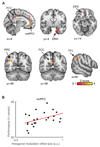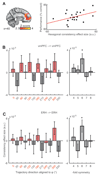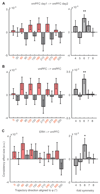Organizing conceptual knowledge in humans with a gridlike code
- PMID: 27313047
- PMCID: PMC5248972
- DOI: 10.1126/science.aaf0941
Organizing conceptual knowledge in humans with a gridlike code
Abstract
It has been hypothesized that the brain organizes concepts into a mental map, allowing conceptual relationships to be navigated in a manner similar to that of space. Grid cells use a hexagonally symmetric code to organize spatial representations and are the likely source of a precise hexagonal symmetry in the functional magnetic resonance imaging signal. Humans navigating conceptual two-dimensional knowledge showed the same hexagonal signal in a set of brain regions markedly similar to those activated during spatial navigation. This gridlike signal is consistent across sessions acquired within an hour and more than a week apart. Our findings suggest that global relational codes may be used to organize nonspatial conceptual representations and that these codes may have a hexagonal gridlike pattern when conceptual knowledge is laid out in two continuous dimensions.
Copyright © 2016, American Association for the Advancement of Science.
Conflict of interest statement
The authors declare no conflicts of interest. All raw data are archived at the Oxford Centre for Functional MRI of the Brain.
Figures




Comment in
-
NEUROSCIENCE. Expanding our mental maps.Science. 2016 Jun 17;352(6292):1378. doi: 10.1126/science.352.6292.1378. Science. 2016. PMID: 27313016 No abstract available.
References
-
- O’Keefe J, Nadel L. The Hippocampus as a Cognitive Map. Oxford Univ. Press; 1978.
Publication types
MeSH terms
Grants and funding
LinkOut - more resources
Full Text Sources
Other Literature Sources
Medical

